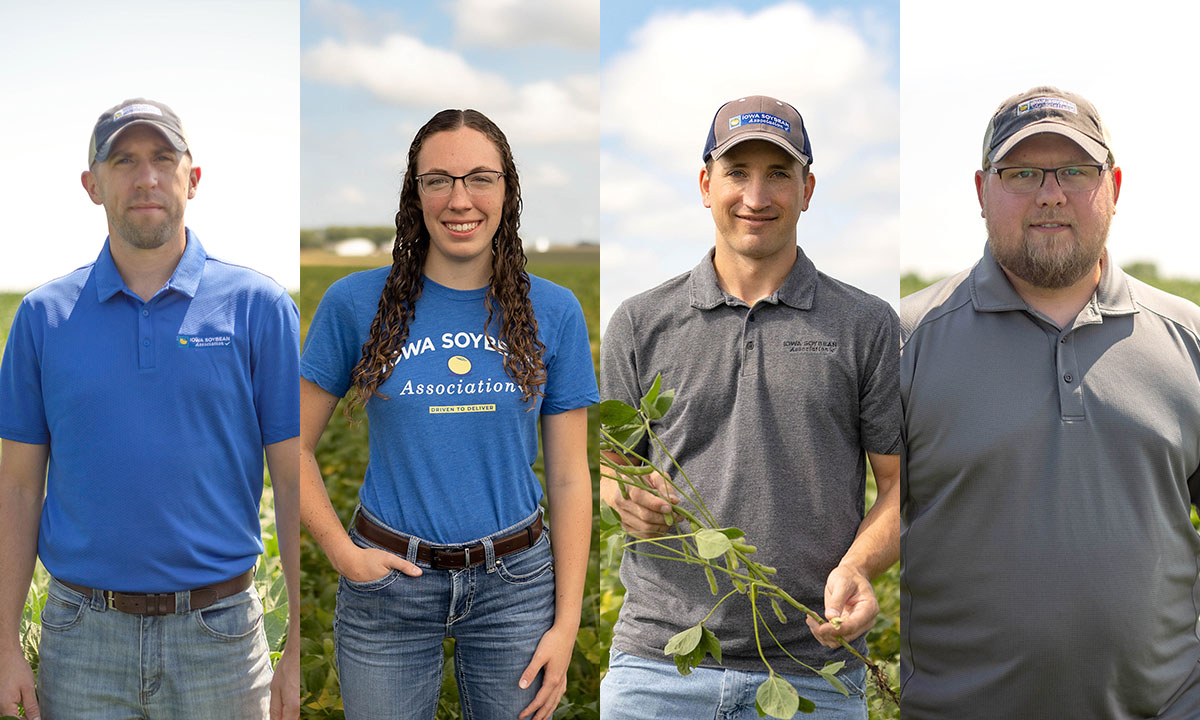
Iowa Soybean Association Conservation Agronomists: (left to right) Dustin Brucker, Rosie Roberts, Ryan Johnson and Joseph Wuebker. (Photo credit: Iowa Soybean Association)
ISA's new conservation agronomists assist farmers and ag retailers with conservation efforts
September 24, 2021 | Kriss Nelson
The Iowa Soybean Association (ISA) is reaching out to more farmers and landowners through a conservation agronomist network launched in August 2020. Its goal: to expand conservation efforts in the state through partnerships and expertise.
There are four conservation agronomists at ISA, with two having relationships with ag retailers that are members of the Agriculture’s Clean Water Alliance (ACWA).
“We have a long history working with ACWA, and we have explored a number of different ways to engage sales agronomists more in conservation delivery,” says ISA Senior Field Services Program Manager Heath Ellison. “We see an opportunity to use the sales agronomy team to reach farmers we don’t normally reach and to assist sales agronomists with potential conservation programs for their clients.” Ellison says the team is tasked with three primary goals:
- Deliver conservation opportunities to the farmer by providing technical knowledge and connecting them with financial assistance, such as cost share programs.
- Build the sales agronomist relationship by utilizing their network and relationships with farmers to promote agronomic and conservation discussions.
- Be the in-house technical expert the sales agronomist and farmer rely on.
Conservation agronomists are currently funded through grants.
An additional goal, Ellison says, is for this effort to demonstrate the value of a conservation agronomist in the ag retail system.
“We have a vision of every ag retailer in Iowa having a conservationist agronomy team member on staff,” he says.
“ISA’s conservation agronomists have a great opportunity to demonstrate the value in having the positions within the ag retail system.”
Dustin Brucker
Dustin Brucker is located at ISA’s office in Ankeny, and is the one conservation agronomist without a specific ag retail partnership.
He works with farmers statewide, although his emphasis is working within the Raccoon River Watershed and supporting others on the team.
Brucker says he helps farmers understand which practices could have the most impact given their local conditions and operational goals.
Another large part of Brucker’s position is helping build awareness of the financial opportunities available in Iowa for farmers to help preserve their land.
“I am here to guide farmers and landowners to Iowa’s financial opportunities and help them navigate the financial process,” he says.
Rosie Roberts
Rosie Roberts is the newest Conservation Agronomist. She is partnering with Cooperative Farmers Elevator (CFE) at its Rock Valley location.
“I serve as a technical resource to all their agronomy support staff and farmers to help implement new conservation practices and be a little more environmentally conscious and focus on how profitability comes into play with those conservation practices,” she says.
Roberts, who is from central Illinois, has been meeting with CFE agronomists and farmers familiarizing herself with the different farming practices in northwest Iowa.
Ryan Johnson
Ryan Johnson is officed at Ag Partners LLC’s Calumet location. This location situates him between two targeted areas in northwest Iowa, the Floyd River and Headwaters of the North Raccoon watersheds.
“There is a lot of excitement about conservation right now. With the carbon credit buzz, that’s an exciting thing,” he says. “We can make a difference by showing farmers they can have conservation on their farms and be profitable at the same time. We are trying to walk them through the process and be as helpful as we can.”
Joseph Wuebker
Joseph Wuebker leads the Iowa Department of Agriculture and Land Stewardship (IDALS)-funded ACWA Farm to River Partnership project. He also works with sales agronomists from Landus Cooperative, NEW Cooperative and Nutrien Ag Solutions.
“These sales agronomists are smart. They are good at what they do, and to be in a position where they feel comfortable getting information from us is a big thing. We are a trusted partner and advisor to farmers,” he says.
Jeff Schleisman is one of NEW Cooperative’s agronomy sales specialists who is working with Wuebker.
“There is always something new with cover crops. It is a topic of conversation, especially in our neck of the woods with the Racoon River Watershed,” Schleisman says.
Once that conversation happens, Schleisman connects Wuebker with the producer.
“The beauty in that is, instead of me having to take on one more thing in the ag retail industry to manage, he takes that relief off me,” says Schleisman. “Joe is here to walk us through the rest of the process and do a heck of a lot better job than I can.”
With the partnership, New Cooperative is able to have a conservation agronomist in its trade area to build relationships with our local agronomists and farmers to make conservation practices easier to adopt and execute, says Dan Dix, NEW Cooperative general manager.
“We can work together to promote conservation practices and find potential cover crop uses.”
Wuebker says there is a three-year project goal in his area to raise 7,000 acres of cover crops a year and to implement 20 edge-of-field practices.
Wuebker is also helping with area water monitoring.
“I compile data so we can see what is actually going on out there,” he says.
Ellison says it has been a fascinating year watching these different methods within the conservation agronomist program develop. There are plans to expand the network.
“By having this field-based expertise, we are influencing the adoption of the practices we want to see grow, practices that are important in achieving the goals of the Iowa Nutrient Reduction Strategy,” he says. “We believe that engaging the ag retail system in this way has the potential to make significant impact on conservation adoption and Iowa’s water quality goals.”
This story was originally published in the October 2021 issue of the Iowa Soybean Review.
Back